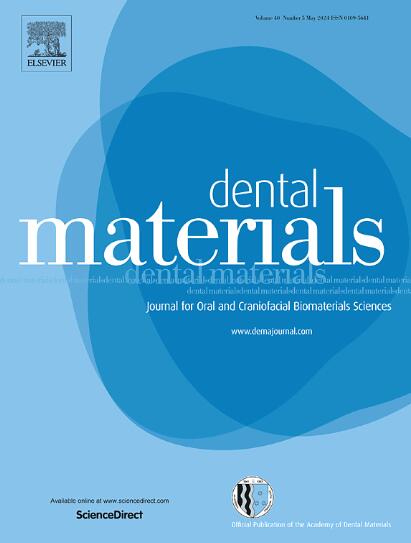不同粘度和化学成分的可流动复合树脂的影响:为期 48 个月的分口双盲随机临床试验。
IF 6.3
1区 医学
Q1 DENTISTRY, ORAL SURGERY & MEDICINE
引用次数: 0
摘要
目的在分口双盲临床研究设计中,评估两种基于甲基丙烯酸酯的可流动复合材料和一种基于ormocer的可流动复合材料在治疗非龋性颈椎病变(NCCL)方面的临床表现:使用通用粘接系统(Futurabond U,Voco GmbH)对 27 名参与者的 NCCL 进行了选择性釉质蚀刻,共进行了 183 次修复:2 名参与者各进行了 12 次修复,3 名参与者各进行了 9 次修复,22 名参与者各进行了 6 次修复。使用了三种不同的可流动复合材料(n = 61):低粘度甲基丙烯酸酯基复合材料(GrandioSO Flow,LVM)、高粘度甲基丙烯酸酯基复合材料(GrandioSO Heavy Flow,HVM)和ormocer基可流动复合材料(Admira Fusion Flow,ORM)。所有修复体均在 48 个月后按照 FDI 和 USPHS 标准进行评估。统计分析采用 Kaplan-Meier 生存分析和 Kruskal-Wallis 方差分析(α = 0.05):结果:48 个月后,17 个修复体脱落:LVM 6颗,HVM 9颗,ORM 2颗。LVM的保留率(95%置信区间)为89.4%,HVM为80.4%,ORM为95.6%,HVM与LVM、HVM与ORM之间差异显著(P 0.05)。没有修复体出现术后敏感或龋病复发:意义:可流动复合材料的粘度增加可能会降低 NCCL 在 48 个月后的临床寿命。基于 Ormocer 和低粘度甲基丙烯酸酯的可流动复合材料在 48 个月后的 NCCL 临床表现良好。本文章由计算机程序翻译,如有差异,请以英文原文为准。
Influence of different viscosity and chemical composition of flowable composite resins: A 48-month split-mouth double-blind randomized clinical trial
Objectives
To evaluate the clinical performance of two flowable composites based on methacrylate and one based on ormocer in treating non-carious cervical lesions (NCCLs) after 48-month evaluation in a split-mouth double-blind clinical study design.
Methods
A total of 183 restorations were performed on NCCLs using a universal adhesive system (Futurabond U, Voco GmbH) with selective enamel etching on 27 participants: two participants received twelve restorations each, three received nine restorations each, and 22 participants received six restorations each. Three different flowable composites were employed (n = 61): a low-viscosity methacrylate-based composite (GrandioSO Flow, LVM), a high-viscosity methacrylate-based composite (GrandioSO Heavy Flow, HVM), and an ormocer-based flowable composite (Admira Fusion Flow, ORM). All restorations were evaluated using FDI and USPHS criteria after 48 months. Statistical analysis was conducted using Kaplan-Meier Survival analysis and Kruskal-Wallis analysis of variance rank (α = 0.05).
Results
After 48 months, 17 restorations were lost: LVM 6, HVM 9, ORM 2. The retention rates (95 % confidence interval) were 89.4 % for LVM, 80.4 % for HVM, and 95.6 % for ORM, with a significant difference between HVM vs. LVM and HVM vs. ORM (p < 0.05). Minor defects were observed in 30 restorations for marginal staining criteria (LVM 12, HVM 10, ORM 8) and in 71 restorations for marginal adaptation criteria (LVM 24, HVM 20, ORM 27) without significant difference between groups (p > 0.05). No restorations showed postoperative sensitivity or recurrence of caries.
Significance
The increased viscosity of flowable composites could reduce the clinical longevity in NCCLs after 48 months. Ormocer-based and low-viscosity methacrylate-based flowable composites showed a successful clinical performance in NCCLs after 48 months.
求助全文
通过发布文献求助,成功后即可免费获取论文全文。
去求助
来源期刊

Dental Materials
工程技术-材料科学:生物材料
CiteScore
9.80
自引率
10.00%
发文量
290
审稿时长
67 days
期刊介绍:
Dental Materials publishes original research, review articles, and short communications.
Academy of Dental Materials members click here to register for free access to Dental Materials online.
The principal aim of Dental Materials is to promote rapid communication of scientific information between academia, industry, and the dental practitioner. Original Manuscripts on clinical and laboratory research of basic and applied character which focus on the properties or performance of dental materials or the reaction of host tissues to materials are given priority publication. Other acceptable topics include application technology in clinical dentistry and dental laboratory technology.
Comprehensive reviews and editorial commentaries on pertinent subjects will be considered.
 求助内容:
求助内容: 应助结果提醒方式:
应助结果提醒方式:


